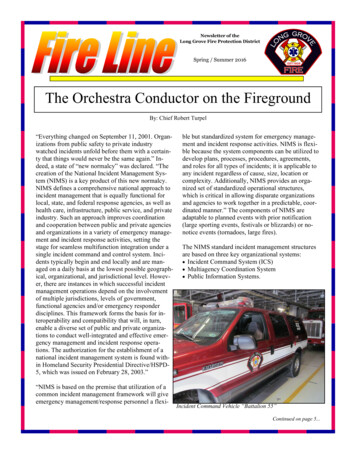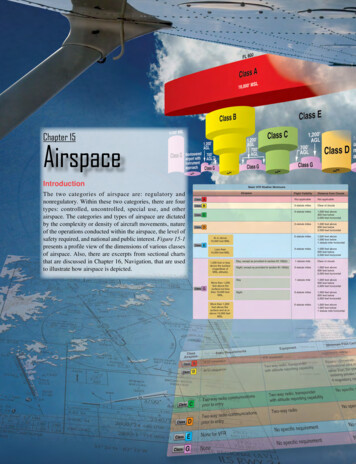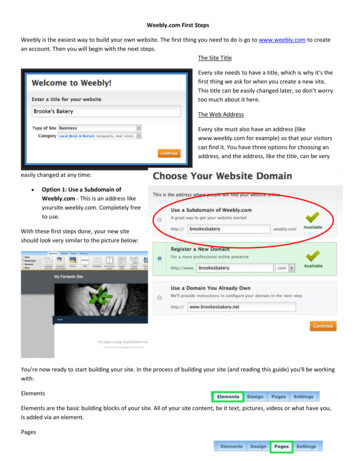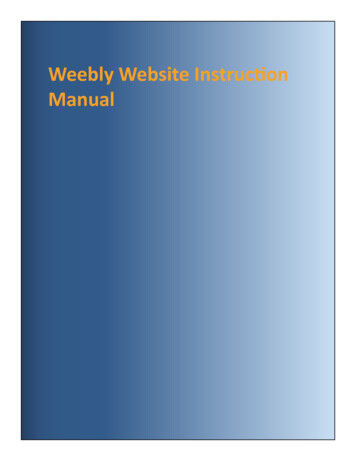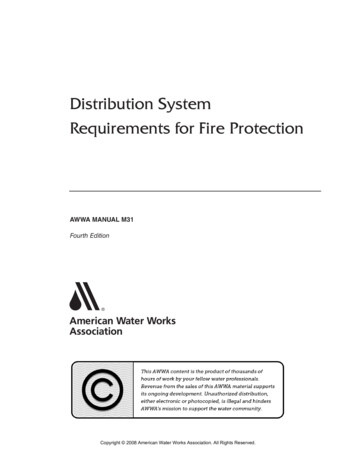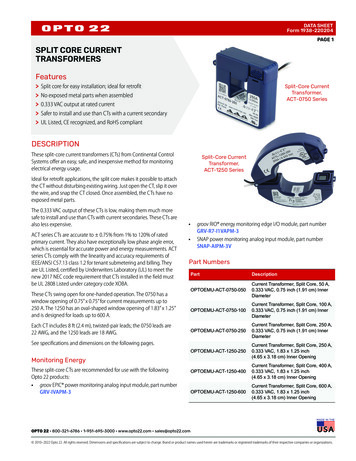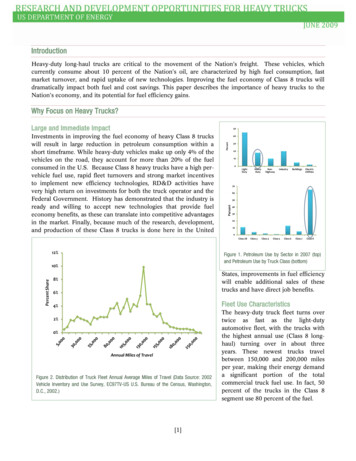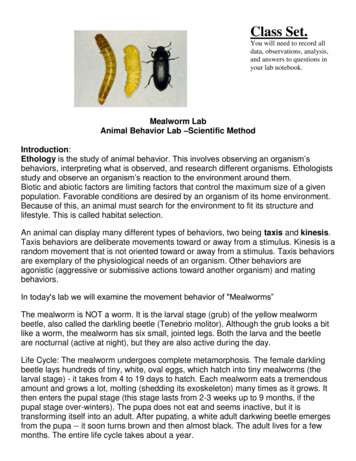
Transcription
Class Set.You will need to record alldata, observations, analysis,and answers to questions inyour lab notebook.Mealworm LabAnimal Behavior Lab –Scientific MethodIntroduction:Ethology is the study of animal behavior. This involves observing an organism’sbehaviors, interpreting what is observed, and research different organisms. Ethologistsstudy and observe an organism’s reaction to the environment around them.Biotic and abiotic factors are limiting factors that control the maximum size of a givenpopulation. Favorable conditions are desired by an organism of its home environment.Because of this, an animal must search for the environment to fit its structure andlifestyle. This is called habitat selection.An animal can display many different types of behaviors, two being taxis and kinesis.Taxis behaviors are deliberate movements toward or away from a stimulus. Kinesis is arandom movement that is not oriented toward or away from a stimulus. Taxis behaviorsare exemplary of the physiological needs of an organism. Other behaviors areagonistic (aggressive or submissive actions toward another organism) and matingbehaviors.In today's lab we will examine the movement behavior of "Mealworms”The mealworm is NOT a worm. It is the larval stage (grub) of the yellow mealwormbeetle, also called the darkling beetle (Tenebrio molitor). Although the grub looks a bitlike a worm, the mealworm has six small, jointed legs. Both the larva and the beetleare nocturnal (active at night), but they are also active during the day.Life Cycle: The mealworm undergoes complete metamorphosis. The female darklingbeetle lays hundreds of tiny, white, oval eggs, which hatch into tiny mealworms (thelarval stage) - it takes from 4 to 19 days to hatch. Each mealworm eats a tremendousamount and grows a lot, molting (shedding its exoskeleton) many times as it grows. Itthen enters the pupal stage (this stage lasts from 2-3 weeks up to 9 months, if thepupal stage over-winters). The pupa does not eat and seems inactive, but it istransforming itself into an adult. After pupating, a white adult darkwing beetle emergesfrom the pupa -- it soon turns brown and then almost black. The adult lives for a fewmonths. The entire life cycle takes about a year.
Anatomy: The tiny, white, bean-shaped eggs are about 2 mm long by .9 mm wide.Larvae are dark yellow with brown bands; they are up to about 35 mm long, have asegmented body, six legs (towards the front of the body) and two antennae. The pupais white/cream with a large head and a pointed tail (it darkens as it grows). Like allinsects, this beetle has a hard exoskeleton, six jointed legs, two antennae, compoundeyes, and a body divided into three parts (the head, thorax, and abdomen). The adultis from 12 to 25 mm long and is dark brown.Diet/Enemies: Both the adults and the larvae are scavengers that eat grains (hence thename mealworm) and some seedlings. Because of this, it is considered a pest. Theyalso eat decaying material, like decomposing animals and dead plants. They get all thewater they need from the food they eat. Mealworms are eaten by many animals,including many birds, rodents, spiders, lizards, and some other beetles.Range: This beetle is found in temperate and other regions around the world. Theyusually live in dark, cool, moist places, like under rocks and logs.PART AGo to the following link or search Virtual Meal Worm Behavior Labhttp://www.mhhe.com/biosci/genbio/virtual labs/BL 19/BL 19.html1. Read the Background and Instructions on the left hand side of thescreen.2. Make a data table in your notebook comparing your predicted response and theactual response for the mealworm for each of the listed stimuli.3. In order to get more stimuli, click Reset, the new stimuli will always appear asStimulus1 and just shift the others over. There are 19 total stimuliBanana SliceMetal Paper ClipsAmmoniaBran FlakesBuzzing AlarmHot WaterApple SliceCooked MacaroniPuff of Air BlowingWaterUncooked MacaroniVinegarApple JuiceFeatherCool WaterLight/DarkLight BeamConstruction PaperCardboard
Journal- Answer these in your lab notebook in complete sentences.1. What is the difference between a reflex behavior and instinctive behavior?Describe reflex behaviors and instinctive behaviors that humans possess.2. Which mealworm behaviors were reflexes? Why?3. Which mealworm behaviors were instinctive? Why?4. How did the mealworm respond to food as a stimulus? What type of behavior isdisplayed in the mealworm's response to food? Why is this behavior important?5. How did the mealworm respond to cold water as a stimulus? Was the responsebehavioral or metabolic?PART BMaterials: The following materials will be needed to complete the experiment: 10meal worms, 2 animal behavior chambers, 2 pieces of filter paper, 1 pencilProcedure:1. First, place the 10 mealworms and some "bedding" into a chamber and takegeneral observations of their movement and interactions for at least 10 minutes.Make a list of the data you have collected. Sketch a Mealworm and try to labelthe "head" and the "tail" of the bug. Notice where they go, how they interact andanything else you may see. Do Not, prod or push them around. Take notes asyou observe their "natural" behavior.Mealworm Sketch
In this experiment, you will see the mealworm’s preference for a wet or dryenvironment. Place two pieces of filter paper in the choice chambers you have (seebelow animation). Make one filter paper wet, but not saturated and leave the other dry.With tweezers, carefully place 5 mealworms on one paper and five on the other.2. Record a Null Hypothesis:3. Record an Alternate Hypothesis:Every 30 seconds count and record the number of mealworms in each chamber. Dothis for 10 minutes, even if the bugs aren't moving. When you are done return themealworms to their container. Count and record the number of animals on each sideof the chamber every 30 seconds for ten minutes, using a table. Be sure to include:time, number of mealworms in the wet vs. dry filter paper at each time, and any otherinteresting observations.3. Graph the number of mealworms in the wet and dry chambersGraphing Instructions: Remember to graph the independent variable on thehorizontal (X) axis and the dependent variable on the vertical (Y) axis. Your graphshould have 2 lines: one representing the mealworms in the moist chamber andanother representing the mealworms in the dry chamber. You can draw the lines indifferent colors or distinguish them by using different symbols for the points on thegraph or the lines themselves (ex. solid vs. dashed). This will be a "dot-to-dot" graph.Be sure to include a legend describing which line represents which chamber.Interpreting Your Graph: If the lines diverge from each other (go away from eachother) at some point, then your mealworms are likely showing a preference for thechamber represented by the line that is mostly going up. If the lines converge on oneanother (criss-cross a lot or are on top of each other a lot), then the mealworms are notshowing a preference for either chamber. Remember, that in science, no result iswrong. It is what it is. If this experiment is done in reality and the mealworms don'tbehave as expected, it may be due to the fact that they are stressed from beingmanipulated for example.
4. Chi Square Analysis on your data to determine whether to reject or fail to reject thenull hypothesis.Expected- how many meal worms did you expect on each environment at the end ofthe 10 min if the independent variables were not affecting the meal worms. (Hint- equal# of mealworms on each available stimuli)Observed- What happened based on your observations? How many were on each sideat the end of 10 min?SHOW ALL YOUR WORK FOR YOUR CALCULATIONS IN YOUR NOTEBOOK!5. Null Hypothesis: Indicate whether to Reject or Fail to Reject6. Repeat the same analysis, but comparing data from all classes.You will need to record your team data on the Spreadsheet.*Enter for your table # only the final # of mealworms that were on eachstimuli after 10 minutes.7. Graph the compiled results8. Calculate Chi Square for the compiled results9. Indicate whether to Reject or Fail to Reject Null Hypothesis10. Did using a larger sample size change your results? Answer in your notebook.
Part C - Student Designed Experiment-InquiryDesign your own experiment, using the same chambers, by thinking of another set ofvariables to test. You could try varying pH, light and dark, warm and cool or any ofmany other tests. You may even want to use more than two petri dishes. Think abouthow you could test multiple variables and leave a control, food preferences forexample? Consult your Lab instructor for )OdorFoodMaterials – just suggestionscold pack, warm packlamps, flashlights, dark construction paper,aluminum foillow pH (HCl), high pH (NaOH)soil, sand, sandpaper, bark, paper, cedar chips,gravelammoniaapple, potato, fish food, lunchmeat1. Begin with a hypothesis, often written as an IF-THEN statement (include in your labreport)Poor: I think mealworms will move toward the wet side of achoice chamber.Better: If mealworms prefer a moist environment, then when theyare randomly placed on both sides of a wet/dry choice chamberand allowed to move about freely for 10 minutes, most will befound on the wet side.2. Use the procedure above as a guideline to design your experiment, and collect yourdata.3. AnalysisDid the mealworms exhibit kinesis, taxis or an obvious preference to oneenvironment over the other? What advantage might this behavior have for themealworm? What was the independent variable in this experiment? What was thedependent variable in this experiment? How could the experiment be improved?Record your lab group’s results.Once all data has been entered, the class will discuss the findings and determinethe best way to display the results.
Mealworm Lab Animal Behavior Lab –Scientific Method Introduction: Ethology is the study of animal behavior. This involves observing an organism’s behaviors, interpreting what is observed, and research different organisms. Ethologists study and observe an
